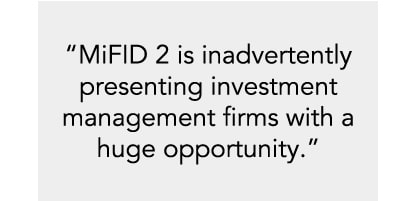By Richard Balarkas
Share post

Richard Balarkas of Compliance Solutions Strategies.
European Fund managers can be forgiven for looking forward to the 3rd January 2018 and, with it, the back of projects like PRIIPS and MiFID 2.
The demands on management time will recede: No more reading regulatory consultation papers, attending project meetings, and answering client questions.
Even the compliance department – who some might say have have acted like mutinous pirates for the last few years, holding the business to ransom whilst they ransacked the capex and IT budgets – might revert to their mild-mannered former selves.
However, beyond the sigh of relief that the industry will no doubt be uttering once the deadline has passed, it’s worth reflecting on the fact that some forward-looking active managers will be embracing MiFID 2 as a new opportunity.
Proving your value-add
Let’s take a step back and remind ourselves what the point of these regulatory initiatives is: to ensure that the investment management industry is truly and transparently aligned with the interests of the end client.
Consider, for example, what is possibly the most radical of all MiFID 2 changes: the unbundling of commissions.
Commission unbundling is being driven by concerns about conflicts of interest. It’s not about a preference for passive versus active management, or excessive spending of client money on low-quality and/or biased research. The use of commissions to pay for research makes it difficult to identify which research is delivering ROI, and which execution services are providing the best value to end investors.
MiFID 2 serves to remind the investment management industry that it’s in business to provide a fair, genuinely valuable service to the people who are paying for it.
Wherever conflicts may be deemed to arise, they need to be managed, and firms must demonstrate that they are being managed.
A new cultural focus on data
To succeed – and indeed survive – in this new world, investment managers must grasp the fact that, above and beyond changes to processes and controls, a cultural shift is required.
This means being honest with ourselves, as well as with our end investors, about the value we add, the resources we use to get there, and who benefits throughout the process.
In the midst of a wide range of regulation-driven process changes, it is data and reporting that will play a huge role in this new MiFID 2 world of alignment and transparency.
Post MiFID 2, firms will be required to record and store unprecedented amounts of data not only about what they did, but why they did it. The whole value chain is affected, from product governance, client suitability, investment decision-making through to broker selection.
As ever, some jurisdictions will interpret the ESMA directives in different ways, and some individual firms will look for wiggle room to do the minimum required in order to comply. But firms that value their reputations will be recording all meaningful decisions and actions so that they are justifiable ex post facto.
Capturing the decision process
When it comes to conversations and decisions that may result in transactions, the new regs go further by requiring firms to record internal conversations between fund managers and their trading desks.
Indeed, anything that contributes to the making of an investment decision (including, it seems, decisions not to invest) is to be recorded and reviewed in order to ensure compliance, especially with regards to managing conflicts of interest.
Whilst preparing for this hasn’t been fun, this turns out to be where MiFID 2 is inadvertently presenting investment management firms with a huge opportunity.
Now available to fund managers is an enormous new data set of every decision and the context in which it is made.

The pain was worth it
By now, we all know that investors – even professional ones – suffer from bias in decision-making and that this is detrimental to investment performance.
In the spirit of Moneyball, the new data footprints created by MiFID 2 can be leveraged to map these behavioral factors and begin the process of controlling their impact. Companies like Essentia Analytics use this data to show fund managers patterns in their investment behavior, whilst “nudging” them to avoid acting on bias.
The proven performance improvement this generates is a win-win for both fund manager and the end investor.
To turn a blind eye to this opportunity – particularly when the data required is already being captured – is not only a bad move commercially, but is exactly what the regulators are trying to protect against.
Best foot forward
There will be plenty of firms that do the bare minimum when it comes to regulation, relying on periodic tick-box exercises.
But given the choice between investing with them, or with a firm that delivers transparent value and leverages data to continuously improve performance, I know where I’d put my money.
Indeed, given the applications of the MiFID 2 data now available, none of us should be surprised to see behavioural analytics becoming a regulatory requirement in the coming years.

